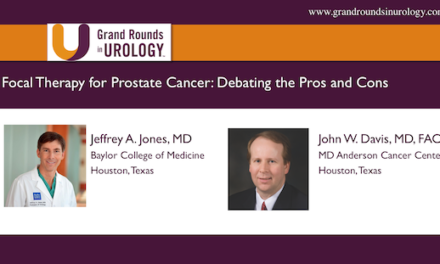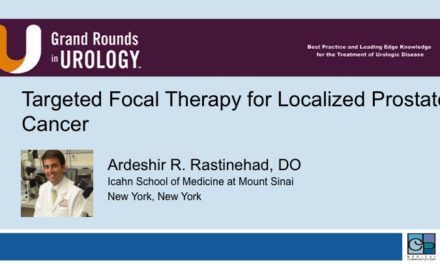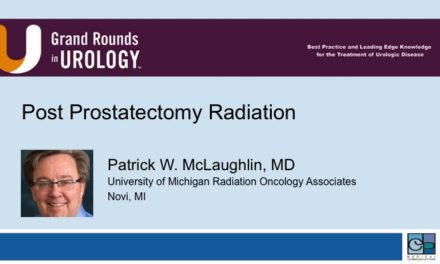Dr. Thomas J. Polascik presented “Highlights from the 9th International Symposium on Focal Therapy and Imaging” at the 27th annual International Prostate Cancer Update meeting on Wednesday, January 25, 2017.
Keywords: prostate cancer, Gleason score, focal therapy, biopsy, 9th International Symposium on Focal Therapy and Imaging
How to cite: Polascik, Thomas J. “Highlights from the 9th International Symposium on Focal Therapy and Imaging” Grand Rounds in Urology. January 25, 2017. Accessed Dec 2024. https://dev.grandroundsinurology.com/highlights-9th-international-symposium-focal-therapy-imaging.
Transcript
Highlights from the 9th International Symposium on Focal Therapy and Imaging
I was asked to speak on some of the highlights of the 9th International Symposium on Focal Therapy, which was held this past June at Duke. This is a two and a half day conference and it’s a real task to cover everything in five minutes. So if you’re invested in a technology─ okay, I will do my best to cover some of the highlights because there are a lot of things that we can’t mention just because of time. So my disclosure is I teach and do research with cryotherapy and Endocare, and I have an RO1 working on the development of acoustic radiation force impulse imaging, and hopefully one day on the commercialization of the products such as that.
There are a lot of key events. The first day we all felt that we needed a teaching course, so we brought in some of our top international radiologists, urologists, and we sat down with urologists who wanted to learn how to read the MRI’s. We did that for a couple of hours. And then we did a hands-on training with fusion biopsies using the – – machine. It was a great session. It lasted almost the whole day, and I think a lot of the people got much out of it.
We then had two consensus meetings. Again, every time we have an international symposium, we try to address some of the burning issues in focal therapy. One of the sessions was on patient selection for focal and the area of active surveillance. And if you want to read about that, it’s in press, PCPD, and the other one was the current utilization of mpMRI in clinical practice. And I think Scott talked a lot about that earlier, and that has been published in the World Journal of Urology.
Patient selection; we try to deal with some of the real contentious issues. What do you do with apical cancers? That is a tough one for anyone who does treatment whether it’s brachy, HIFU, cryo, etc. How do you deal with the salvage patient, and what do you do with the high risk prostate cancer patient, the Gleason 4+3 is the ace. We talked a little bit earlier today about high volume Gleason 6. It’s usually the harbinger for Gleason 7 disease.
We had a nice discussion point-counterpoint biopsy, a nice debate comparing transperineal mapping versus TRUS actually by people in this audience, and then we had a nice debate by Hash Ahmed and Art Rastinahad looking at can we just do targeted alone or do we have to combine that with a systematic 12 core biopsy. We then had a whole panel of experts discussing as the next step multiparametric ultrasound. Is this hype or hope? And the moderators included a urologist, a radiologist, and a biomedical engineer.
We talked about ultrasound contrast, what can be done in an office setting, personal experience, using ARFI, and then Sanji Guy presented his study on very high resolution, 29 megahertz, microultrasound. So I think things are getting better. We did reach some consensus with patient selection. In terms of disease factors we felt that low and intermediate risk groups were appropriate. The sweet spot was 3+4, localized, away from neurovascular bundles, a PSA of up to ten.
In terms of volume we thought that 1.5 cc was a good target. You can do up to 3 cc if you are bleeding a whole lobe in hemiablation. And considering life expectancy, trying to preserve erectile function, and gland size in general is not a contraindication to many detect technologies, and neither is mild to moderate TRUS.
So we like to stir things up because this is a good forum to do that. If you are going to start doing new things, you have to have a discussion. So we looked at the potential role for multiparametric MRI in screening. We had an expert from Europe, Canada, and the U.S.A. So the conclusion was in Europe, I think they were open to it was mentioned earlier that things are very inexpensive. They have a cheaper version of an MRI for about 300 euros that can be done. They are trying to do this. The issue right now is they are working on optimization. They have to get all of their readers up to speed and all of the rest.
In Canada it was felt that no one of the biopsy naïve men, but up to some discord information, it sounds like a good idea. The problem in Canada is one of resources. Right now they don’t have enough and they have excessive wait times. And then in the U.S. the problem is the cost. It’s very expensive, so we figure, well, what can we do? It was talked about earlier that the DCE is not the most informative part unless you’re looking at recurrence.
What about if we did a biopsy-parametric as was discussed earlier? That may be one way to slow down the cost. Anterior tumors, as was mentioned before, I think this is a new entity. This is a new disease entity that can potentially be treated with focal. We had a number of trial updates that talked about a number of these different technologies. And then one of the best parts of this is that we had videos. You can see new techniques. Wow, here are just a few of them, multiparametric ultrasound in an office setting. Dave Crawford talked about precision prostate tumor mapping for focal therapy.
Jack Tay did anterior gland ablation. Larry Klotz, MRI guided TULSA, we heard about that this morning. Arnauld Villers, he showed us how he does effusion biopsy in five minutes from start to finish. Interstitial vapor therapy for prostate cancer; we had a gentleman that says he does prostate cryotherapy in the office. I think these are really provocative. The videos I think were really the best part, and then finally Arnauld Villers showed his video on anterior partial prostatectomy using the robot.
So what is new; – – DaVinci from Hopkins talked about his experience with robotics. I think we’re moving towards robotics. Maybe the human hand is not precise enough to get to the same location every time. We talked about 3D mapping, biomarkers, epigenetic mapping, PSMA targeted markers. We talked about follow-up, how it should be done. We had radiologists define radiologic success. We had pathologists defining pathologic success and failure.
I wanted to state that if you wanted to look at the meeting, you can still access it under Focal Therapy 2016. It was filmed by the SIU, and it’s available on their website if you want to see any of the podcasts. And the next meeting, Focal Therapy 10, will be held in the Netherlands on June 18-20. You are all welcome to come if you’d like. Thank you for your attention.
Q&A
Q&A Transcript
EASTHAM: So you can submit questions if you’d like. I will start since Dr. Crawford is here, and actually one of the videos that was presented. David, you have presented a lot on transperineal mapping biopsies and how those are incredibly important for appropriately selecting patients for focal therapy and the like. What are your thoughts on that versus multiparametric MRI, and what is done at Duke in terms of patient selection for focal therapy? We can start with that one.
CRAWFORD: Thank you. Well, you know, that’s a very good question. And this morning when I was talking I said that in every cancer that we treat, we stage it. We do a PET scan, CT, bone scan, everything, and in prostate cancer we sort of make life and death decisions based on random transrectal biopsies. So the next step is the anterior gland, and there are the people that are the MRI folks. And depending on who you believe and how great it is, I think it’s the people that are good at it, are good at it. The average person isn’t so good at it, in my opinion.
We have been doing these transperineal mapping biopsies, and so has Tom and other people, and there are various ways for a decade now. And I think we’ve done 1,000 of them and we find that it is the way to interrogate the gland. I showed you this morning. It’s as accurate as a radical prostatectomy.
Not everybody does it the way we do it. They lump them together; they’ll do this quadrant and that quadrant. And in the study that – – did that was presented this morning, and Mark, they did mapping biopsies. But, they did not do them the way we do them. That was one of the problems with that study.
If you do that, you know where the cancer is. That’s the hard part; a blade in it’s the easy part. You can cryo, lasers, this, that, one thing after another.
I don’t think you have to limit yourself to Gleason 6 cancers. I mean, that was the argument. Well, you’re doing all this targeted therapy, and then you’re treating Gleason 6 cancers that don’t need to be treated, anyway. That’s okay; at least you don’t have to follow them so carefully.
Then we got into three fours, the four threes, and the eights. Gary Onik, the guy who started all this stuff a long time ago, and who has been at this meeting many times, he was treating Gleason 8s. People were laughing at him, “You’ve got to be out of your mind doing that.”
If you actually know where it is—and Gary and Winston Barzell actually pioneered a lot of this stuff—I think that mapping biopsies, are – -, but they’re a pain in the butt.
Tom, what do you think?
POLASCIK: I agree. I did mapping and MRI for everyone, and this is the problem. Patients came in and said, “I want focal.”
I said, “Okay. Well, how confident do you want to be that we’re locating the cancer and we’re getting it all? And they said, “I want to be very confident.”
Then we go to mapping biopsy. Then we start finding all this stuff. Then they want surgery. Sometimes when you start going down that focal path, then they want surgery, then you’re thinking, Maybe I shouldn’t have done all that, because – – out anyway.
I think now we do maybe a of that. I ask them how confident they want to be. I think you should have probably 12 cores in the untreated area, at least.
Most of these failures—we know that MRI is going to miss anywhere from 5%–15% of clinically significant tumors. We know that. Unless you’re supplementing by biopsy, they’re going to come back.
MALE VOICE 2: How confident do you want to be before you recommend focal therapy? Do you just need an MRI with a targeted biopsy plus 12 cores? Or do you want a transperineal quadrant biopsy?
What’s your—Mr. Smith comes in. He’s had an outside biopsy, shows unilateral disease, an MRI that looks relatively normal—PI-RADS 1, 2. Is that enough information for you to say, “We’re ready to go to the operating room, and we’ll use some energy source to ablate half your gland.”
I’m just throwing this out.
POLASCIK: On the one hand, I like to be very confident for the patient’s sake. On the other hand, we’re trying not to do more biopsies.
VOICE 2: Right.
POLASCIK: But, I think these things are going to come back and bite us in the foot, at some point. The reality is we’re seeing short-term studies now—couple years. I’m interested to see if those reports are going to extend out five and ten years, because I think if they do, we’re going to see more cancers coming back, just because the biopsy wasn’t thorough enough, the interrogation wasn’t thorough enough initially.
MALE VOICE 2: There’s at least a couple of questions. The first question was: When you’re doing the anterior freeze technique that you demonstrated, or showed slides of, do you use the temperature probes to monitor the temperature anteriorly? And that’s done hopefully to prevent penile . Or what kind of monitoring do you do intraoperatively, specifically for the anterior freeze?
POLASCIK: The answer is no. I haven’t really seen penile numbness. I’ve done over 500, 600, 700 cases. I’ve maybe seen it a couple times. It’s more common in the salvage setting.
This anterior gland ablation is no different than whole-gland cryo, and I don’t normally monitor the temperature there.
I do put a thermocouple at the rectal wall at the rectal wall and at the apex and monitor the sphincter. Then I may monitor one of the neurovascular bundles just to make sure that stays warm.
MALE VOICE 2: Then the following question, we touched on a little bit this morning, but it has to do with immunology. Do you think the release of neoantigens—when you ablate tissue, however you do it—they said HIFU in the question, but I’m sure it’s released by other energy sources, as well.
How much of a role, if any, do you think that plays?
POLASCIK: Again, I’m a believer. It’s not just HIFU, but with any of the ablative technologies that you’re releasing antigens and you can harvest the immune system. I’m just not aware of anyone who’s figured out a real good way to do it at this point in time.
One of the HIFU companies came by within the last year and wanted to know if we, or anyone that I know of, has figured out what that holy grail is. I’m not aware of anyone.
Like I said, for cryo, I think the best we have right now is vitamin D, which is very easy. You get a vitamin D level, you load it up, and you don’t need to hit those extremely cold temperatures to achieve cell death. But for HIFU, I’m not aware of anything at this point in time.
MALE VOICE 2: When you use cryotherapy, do you use vitamin D outside of a clinical trial at this point?
POLASCIK: I recommend it; whether patients take it or not is another.
MALE VOICE 2: [Interposing] What do you recommend just for folks that do cryotherapy? What do you recommend? What kind of dosing, and for how long?
POLASCIK: Vitamin D2 would be 50,000 international units. Or for vitamin D3, I think 5,000 a day is reasonable, and for several weeks. Most people, by the time you go in the OR schedule, it’s four–six weeks, so I think that’s a good window.
Most Americans are very low in vitamin D anyway, especially in the winter months. You’re probably just trying to get their levels anywhere near normal. I don’t think they’re not going to become super therapeutic around here.
MALE VOICE 2: I may have misinterpreted it, but in one of the slides you showed for focal ablation, there was still about a 50% erectile dysfunction rate. That seems pretty high for a focal therapy.
Is there anything that can be done, other than completely missing the neurovascular bundle, to make that rate better? It just seems like a high rate for a focal therapy.
POLASCIK: Yeah. If you look at all the series—I’ll speak on cryo—the rate for potency ranges between 60% and 90%, overall. Half of those men who are considered potent are actually taking oral medication. That’s been seen in multiple single-center series.
The COLD Registry is a little bit lower; I think largely because there’s no set way of doing it. You have many, many people doing it, some of which don’t really have the volume or the expertise. It’s kind of a big picture.
I think we’ve also tried to put warming rods outside the prostate at the vicinity of the neurovascular bundle, but that didn’t really work, because then you have a cold-warm interface. That wasn’t very effective for a cancer-control point of view. And it didn’t really do very much for the potency issue.
ABOUT THE AUTHOR
Thomas J. Polascik, MD, FACS, is Professor of Surgery at Duke University Medical Center and the Director of Surgical Technology at the Duke Prostate and Urological Cancer Center. He is the Founder and Co-Director of the International Symposium on Focal Therapy and Imaging of Prostate and Kidney Cancer, which began at Duke in 2008. Dr. Polascik is the Editor of Imaging and Focal Therapy of Early Prostate Cancer. He is Founder and President of the Focal Therapy Society, as well as Director of Duke’s Society of Urologic Oncology Fellowship Training Program and the Genitourinary Program on Focal Therapy at the Duke Cancer Institute. He is the Medical Director of Duke’s Men’s Health Initiative Screening Event and is a governing member of several medical boards and societies. His clinical and research interests focus on prostate and kidney cancer. He has authored over 350 peer-reviewed manuscripts and book chapters.





